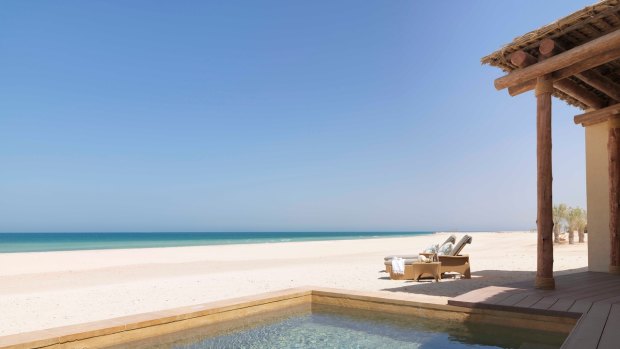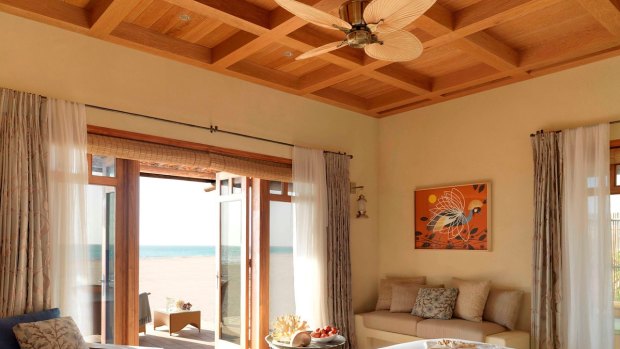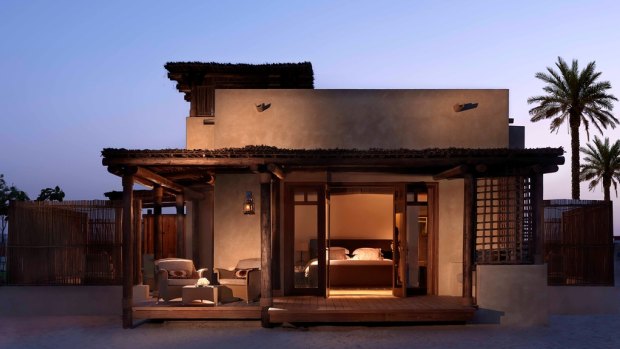This was published 9 years ago
Anantara Al Yamm Villa Resort, Abu Dhabi review: Desert island escape
By Leisa Tyler

Al Yamm is the second - and most luxurious - resort to open on Sir Bani Yas.
Overlooking a giant swath of golden sand on the eastern shoreline of Sir Bani Yas, Al Yamm Villa Resort is the second resort by Bangkok-based hotel and resort group Anantara for this Persian Gulf isle.
The location
The once private retreat of the United Arab Emirates' founder, the late Sheikh Zayed Bin Sultan Al Nahyan, Sir Bani Yas is an 87-square-kilometre island sitting nine kilometres off the coast of the Emirates which was converted into a wildlife park a few years ago. Equipped with millions of trees and stocked with exotic wild animals from the Gulf and nearby African countries, the park was designed to both breed animal species that are endangered or extinct in the wild, plus offer tourists and Gulf residents an opportunity to explore the great outdoors on safari trips by vehicle and horse.

Each villa is spacious and finished with polished concrete floors, rustic wooden furniture, Japanese-style wooden bath tubs and oversized shower heads.
Opened in September 2013, Al Yamm is the second - and most luxurious - resort to open on Sir Bani Yas. The first, family friendly Desert Island, was converted out of the Sheikh's old guest house in 2008. The third, Al Sahel, earlier this year overlooking a forest of stubby acacia trees on the central savannah.
The space
Clad in clay brown, 30 stand-alone villas spread out like bird's wings from a central lobby and pool area. Mimicking the traditional barasti huts of Arabic fishing and pearl diving villages, each is spacious and finished with polished concrete floors, rustic wooden furniture, Japanese-style wooden bath tubs and oversized shower heads. Late-minute additions to the room - walls and doors separating the bathroom from a previously open space plan - have left a few dead spaces and an impossibly tight corner to store luggage, but that's made up for with generous amenities: A Lavazza espresso machine, complimentary snacks, Anantara's ginger and herbal soaps and a lounge stocked with glossy magazines.

Clad in clay brown, 30 stand-alone villas mimic the traditional barasti huts of Arabic fishing and pearl diving villages.
It's the villas' outside spaces that take first prize, with cosy daybeds and a lounge area atmospherically shaded by sticks entwined with rope, staring out onto an enormous swath of snow white sand and beyond, water the colour of aquamarine, or a small bay and mangrove forest.
The food
The onsite Italian restaurant, Olio, with floor to ceiling windows and a shady deck, serves Mediterranean inspired cuisine with some produce flown in weekly from Italy. Think angel hair pasta with pesto; buffalo ricotta with semi dried tomatoes; baked local lobster. It's as good as can be expected for a remote desert island, although staff have a habit of swapping imported ingredients with local alternatives and not informing guests.
Al Yamm guests are free to access the restaurants at Desert Island and Al Sahel; Anantara providing transfers to both lodges free of charge and central billing. Pick of the bunch is the tapas bar Amwaj, a gorgeously breezy spot under the shade of Desert Island's Watersports Centre with stunning views over the sky-blue water, fantastic service and a delicious array of Levantine dishes like kibbe, babaganoush, meat balls in a rich tomato sauce, hummus and perfectly piquant salads.
Sir Bani Yas' other great eating experience is called Dining by Design and involves a chef and two waiters setting up an exclusive and very beautiful barbecue dinner on the beach. I had mine on the sand dyke at Al Yamm with a wooden pavilion draped in sheer white curtains and separate wooden lounge and dining tables lit with a myriad of candles. Teamed with beautifully crisp wine, staff prepare extravagant feasts with kitchen specials like stuffed peppers, pickled aubergine, black olives, flat breads and barbequed seafood.
Worth stepping out for
Al Yamm doesn't have many resort-based facilities, par a big and well attended pool, an ill-equipped gym and spacious homestead-like reception area with lots of nook and cranny couches to curl up with a book, glass of wine or both.
But non-resort activities are plenty, and the main reason to come to the island. Before being established as a private nature reserve for Sheikh Zayed in 1971, Sir Bani Yas hadn't been inhabited for hundreds of years. Once a popular stop over for traders plying between Mesopotamia, an area in northern Syria and Iraq which is widely considered the cradle of civilisation, and India and China, the island is the site of the oldest Christian monastery in the United Arab Emirates, which dates back to 600AD. Fragments of the monastery were recently unearthed, alongside cooking pots, glass vessels and lamps from China. The complex's outer walls are still visible and can be visited via a five minute drive from Al Yamm.
Adventure is inland, in the burnt orange wadi's- or mountainous out crops- forming the island's heart and the extensive savannah lands. Here 30 animal species, some of them considered critically endangered or threatened by the IUCN roam free. They include the Arabian oryx, which was recently reintroduced into the wild after becoming extinct, sand gazelles, urial sheep, hyrax- a small pudgy mammal no bigger than a marmot which is oddly related to the elephant, plus cheetahs, giraffes and more
Guests can do safaris by open top vehicles, mountain bike, foot or one of the perky and well maintained horses (they actually live in air conditioned stables). Donne some covered shoes to follow the groups of giraffes as they trot through the scrubby acacia trees; most areas of the park are accessible to tourists- except where the cheetahs live.
Don't miss: Paddling kayaks across the shallow but crystal blue estuary and through the narrow labyrinth of a mangrove forest to spot kingfishers and flamingos fishing for their dinner.
The writer travelled as a guest of Anantara and Etihad Airways
Trip notes
Getting there
Etihad Airways fly between Sydney and Melbourne and Abu Dhabi daily. See Etihad.com
Rotana Jet have daily flights from Al Bateen Executive Airport in Abu Dhabi to Sir Bani Yas from AED 200. See rotanajet.com
Staying there
Al Yamm has 30 stand-alone villas with magnificent views over Sir Bani Yas' golden sands. Villas, double occupancy, from AED1360, including breakfast. See al-yamm.anantara.com.
Sign up for the Traveller newsletter
The latest travel news, tips and inspiration delivered to your inbox. Sign up now.